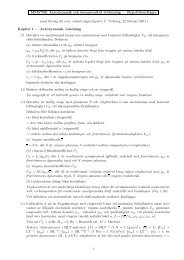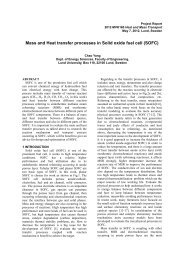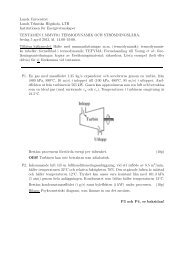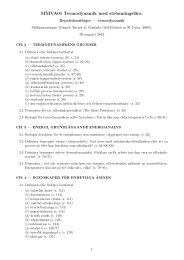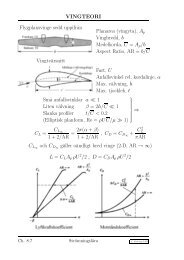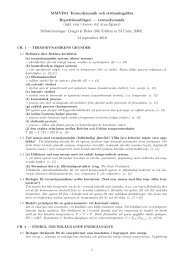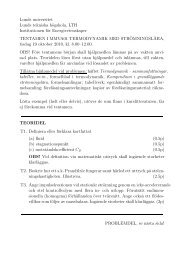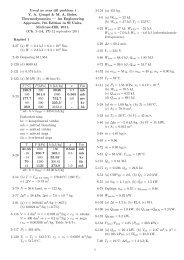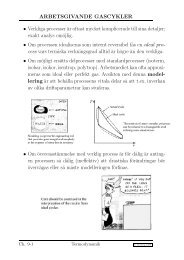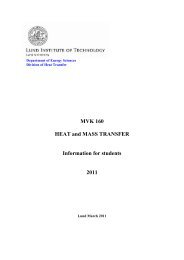INTRODUCTION TO HEAT EXCHANGERS
INTRODUCTION TO HEAT EXCHANGERS
INTRODUCTION TO HEAT EXCHANGERS
Create successful ePaper yourself
Turn your PDF publications into a flip-book with our unique Google optimized e-Paper software.
<strong>INTRODUCTION</strong> <strong>TO</strong><br />
<strong>HEAT</strong> <strong>EXCHANGERS</strong><br />
Bengt Sundén<br />
Lund Institute of<br />
Technology
What is a Heat Exchanger?<br />
A heat exchanger is a device that is used to<br />
transfer thermal energy (enthalpy) between<br />
two or more fluids, between a solid surface and<br />
a fluid,<br />
or between solid particulates and a fluid,<br />
at different temperatures<br />
and in thermal contact.
Classification of heat exchangers
Heat exchangers are classified according to<br />
• Transfer process<br />
• Number of fluids<br />
• Degree of surface contact<br />
• Design features<br />
• Flow arrangements<br />
• Heat transfer mechanisms
Fig. 1 Fluidized-bed heat exchanger.
Fig. 2 Heat transfer surface area density spectrum of<br />
exchanger surfaces ( Shah, 1981).
Fig. 3 (a) Shell-and- tube exchanger with one shell pass<br />
and one tube pass;<br />
(b) shell-and- tube exchanger with one shell pass<br />
and two tube passes.
Fig. 4 Standard shell types and front- and<br />
rear-end head types (From TEMA, 1999).
Fig. 5 Gasketed plate-and-frame heat exchanger.
Fig. 6 Plates showing gaskets around the ports (Shah and Focke, 1988).
Fig. 7 Section of a welded plate heat exchanger.
Fig. 8 Bavex welded- plate heat exchanger.
Fig. 9 Spiral plate heat exchanger with both fluids in spiral counter flow.
Fig. 10 (a) Lamella heat exchanger;<br />
(b) cross section of a lamella heat exchanger,<br />
(c) lamellas
Fig. 11 Printed-circuit cross flow exchanger
Fig. 12 Corrugated fin geometries for plate-fin heat exchangers:<br />
(a) plain triangular fin; (b) plain rectangular fin;<br />
(c) wavy fin; (d) offset strip fin;<br />
(e) multilouver fin; (f) perforated fin.
Fig. 13 (a) Individually finned tubes;<br />
(b) flat (continuous) fins on an array of tubes.
Fig. 14 Individually fin tubes.
Fig. 15 Heat wheel or a rotary regenerator made<br />
from a polyester film.
Classification according to transfer process<br />
Indirect contact type<br />
Direct contact type<br />
Direct transfer Storage Fluidized bed Immiscible<br />
fluids<br />
Gas-liquid<br />
Liquid-vapour<br />
Single-phase<br />
Multiphase
Classification according to number of fluids<br />
Two-fluid Three-fluid N-fluid (N > 3)<br />
Classification according to surface compactness<br />
Gas-to-liquid<br />
Liquid-to-liquid and phase-change<br />
Compact<br />
β≥ 700 m 2 /m 3<br />
Non-compact<br />
β < 700 m 2 /m 3<br />
Compact<br />
β ≥ 400 m 2 /m 3<br />
Non-compact<br />
β < 400 m 2 /m 3
Classification according to design or type<br />
Tubular Plate-type Extended surface Regenerative<br />
PHE Spiral Plate coil Printed<br />
circuit<br />
Plate-fin<br />
Tube-fin<br />
Gasketed Welded Brazed<br />
Ordinary<br />
Separating<br />
wall<br />
Heat-pipe<br />
wall<br />
Double-pipe Shell-and-tube Spiral tube Pipe coils<br />
Cross-flow<br />
to tubes<br />
Parallel flow<br />
to tubes<br />
Rotary Fixed-matrix Rotating<br />
hoods
Classification according to flow arrangements<br />
Single-pass<br />
Multipass<br />
Counter flow Parallel flow Cross flow Split flow Divided flow<br />
Extended surface<br />
Shell-and-tube<br />
Plate<br />
Cross- Cross-<br />
Counter flowparallel flow<br />
Compound flow<br />
Fluid 1 m passes<br />
Fluid 2 n passes<br />
Parallel counter flow<br />
m-shell passes<br />
n-tube passes<br />
split-flow<br />
Divided-flow
Classification according to heat transfer mechanisms<br />
Single-phase convection on both sides<br />
Single-phase convection on one side,<br />
Two-phase convection on other side<br />
Two-phase convection on both sides<br />
Combined convection and radiative heat transfer
Classification according to process function<br />
Condensers<br />
Liquid-to-vapor<br />
phase-change<br />
exchangers<br />
Heaters Coolers Chillers
Convective heat transfer<br />
Fluid1<br />
vägg<br />
Fluid2
Overall heat transfer coefficient<br />
Q<br />
= UA⋅Δt<br />
m<br />
=<br />
1<br />
⋅Δt<br />
TR<br />
m
Expression for overall thermal<br />
resistance<br />
1<br />
TR=<br />
α A<br />
i<br />
i<br />
1<br />
+<br />
α A<br />
Fi<br />
i<br />
b<br />
+<br />
w<br />
λ A<br />
w<br />
vl<br />
1<br />
+<br />
α A<br />
F<br />
o<br />
o<br />
1<br />
+<br />
α A<br />
ó<br />
o
Values of the heat transfer<br />
coefficient W/m2K<br />
• Air atmospheric pressure 5-75<br />
• Air pressurized 100 - 400<br />
• Water, liquid 500-20 000<br />
• Organic liquids 50 000<br />
• Boiling 2 500 -100 000<br />
• Condensation 3 000-100 000
Correlations for the heat transfer<br />
coefficient<br />
• Nu = hL/k = function (flow velocity, physical<br />
properties, geometry) = function (Re, Pr,<br />
geometry)
General research needs<br />
• How to achieve more compact heat exchangers<br />
• High thermal efficiency<br />
• Balance between enhanced heat transfer and<br />
accompanied pressure drop<br />
• Material issues especially for high temperature<br />
applications<br />
• Manufacturing methodology<br />
• Fouling<br />
• Non-steady operation



